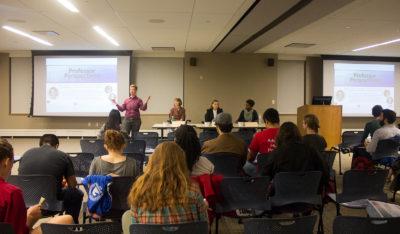
In 1964, Ruth Glass, a British sociologist, coined the term “gentrification,” describing it as the displacement of the “social character of a district” because the inner working class neighborhoods of London were “invaded by the middle class,” with their elegant tastes, Glass wrote in 1964.
On Oct. 25, sociology professor Japonica Brown-Saracino and PhD candidates Taylor Cain and Sarah Hosman hosted a discussion titled “Gentrification in Boston: Are You a Gentrifier?” The panel was held in partnership with the Boston University Community Service Center to discuss gentrification, placed within the context of Boston neighborhoods such as Jamaica Plain, Allston, Roxbury and Dorchester.
The discussion comes at a pertinent time since Boston is becoming more expensive, according to a U.S. Census Bureau’s American Community Survey provided by Brown-Saracino in the presentation.
In 1999 Boston’s median home value was $210,100, with only 39 percent of households paying more than 30 percent of income on rent. While in 2015, an estimate shows that the median Boston home value was $453,000, and more than 50 percent of families were paying more than 30 percent on rent, according to the survey shown by Brown-Saracino.
Boston residents are also more educated today than ever before: almost half of Boston’s residents now hold a BA or higher, according to a survey from U.S. Census Bureau.
Joey Nguyen, a graduate of the University of Massachusetts Boston, says his family was forced to move out of Boston because they could not afford Boston’s increased cost of living.
“I live in Quincy because my family couldn’t afford to stay in Dorchester … we were considered more fortunate than other folks but we’re seeing it all with our friends, our families, our communities,” Nguyen said. “My mother has a restaurant in Egleston Square and the demographics of the customers are drastically changing, so we see it on a day to day basis. I mean, we’ve been around for 25 years.”
Especially in densely student-populated neighborhoods like Allston — which an article written for the Boston Business Journal in 2015 said was beginning to “Brooklynize” — gentrification has affected those that originally inhabited the community.
According to interviews of Allston residents conducted by panelist Hosman, during the ‘80s Allston was known for heroin use and brawl-induced “sidewalks full of blood.”
A clean-up by Allston “pioneer” residents, commercially upscaled the area so that it instead became known for events like Sunday brunch. Allston therefore became, according to one bar-owner that Hosman interviewed, a place people “would want to go.”
As a neighborhood like Allston becomes more upscale, families that historically live in these neighborhoods are affected, as their community — now designated as up-and-coming — attracts new residents, who can pay higher rents the traditional families can’t afford.
“Even [in] a place like Allston that tends to have a lot of BU students concentrated in the gap area … there are families that live in the gap with small children,” Hosman said. “Just being mindful that these are existing communities of people, and they want to work with students, but you know, it’s kind of a two-way street.”
Stacy Ulrich, BU College of Arts and Sciences director of Student Programs and Leadership, who oversaw the discussion, echoed the importance of BU students being mindful of the role gentrification has played in Boston communities.
“BU students don’t necessarily know that much about the neighborhoods they live in and who the traditional inhabitants of those neighborhoods have been,” Ulrich said. “ I don’t know that they think that much about themselves as residents of the neighborhood where they’re living in, so they’re not necessarily civically engaged in that neighborhood.”
As college residents of a neighborhood, Ulrich said that it is important to remain cognizant of the effect gentrification has on the communities students are inhabiting.
“These three, four, five, six years that you’re spending here are really important and formative,” Ulrich said. “And so, I hope this opens their eyes to thinking about the neighborhoods that they’re living in.”
Caroline Kohler, a junior in Sargent College and a program manager of the CSC, also said it is important for BU students to understand the effect of gentrification on communities.
“There are definitely examples in almost every community in Boston about residents who have been there for a very long time seeing it change,” Kohler said. “It can seem like a very lofty topic, but we want to make this really applicable to students and how they can help support communities that are already established.”
Doing so might help residents of communities of which the new store-front or restaurant, hits the hardest.
“This is my city and I hope I can stay here,” Nguyen said. “But, that’s the tricky part, right?”























































































































